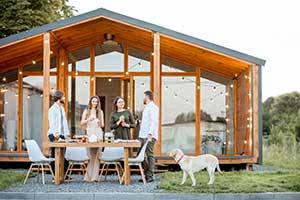March 18, 2024 by John Vermeulen

In today’s real estate market, sellers are constantly looking for ways to increase the value and appeal of their properties. One innovative strategy that has gained popularity is the incorporation of Accessory Dwelling Units (ADUs). These additional living spaces not only offer a unique selling proposition but also open up new streams of income, significantly enhancing seller opportunities.
What is an ADU?
An ADU, or Accessory Dwelling Unit, refers to a secondary housing unit on a single-family residential lot. It can be detached from the main house (like a backyard cottage), attached (such as over-the-garage apartments), or even located within the primary residence (as in basement conversions). Regardless of its form, an ADU provides complete independent living facilities including sleeping areas, kitchen space, and bathroom facilities.
The Financial Benefits
Increased Property Value
The addition of an ADU significantly boosts property values. By offering more than just extra square footage – essentially providing another fully functional home on the same plot – these units make properties more attractive to potential buyers who see them as investments with immediate rental income potential.
Rental Income Stream
One clear advantage is creating an ongoing source of passive income through rentals. Whether it’s long-term leasing or tapping into short-term vacation rental markets like Airbnb or VRBO; homeowners can secure steady cash flow which can help cover mortgage payments and other expenses associated with property ownership.
Market Appeal Enhancement
By showcasing an existing ADU during sales listings or discussing the possibility for future development, sellers directly address growing buyer demands for flexible living arrangements—be it accommodating extended family members comfortably without sacrificing privacy or having readily available guest quarters that double as revenue generators when not in use by friends and family.
Navigating Regulatory Landscape
It’s important for sellers to understand local zoning laws and regulations concerning ADUs since they vary widely across different jurisdictions. Being well-informed allows sellers to effectively communicate these possibilities—or limitations—to interested buyers thus avoiding any misinterpretations that could derail negotiations down the line.
Moreover, presenting detailed plans approved by local authorities alongside cost estimates from contractors can further entice prospective buyers by reducing perceived hurdles related to constructing such units themselves post-purchase.
Conclusion
The inclusion—or potential inclusion—of accessory dwelling units offers multifaceted benefits ranging from increased financial gains through enhanced market attractiveness leading towards faster sales cycles at potentially higher price points due largely because they meet current trends favoring versatile housing solutions capable supporting various lifestyle needs efficiently under one roof while simultaneously fostering community connections given their inherent design promote closer yet distinctly separate household configurations amidst burgeoning urban sprawl scenarios nationwide thereby solidifying their role integral components forward-thinking real estate strategies aimed maximizing homeowner returns midst shifting demographic preferences increasingly valuing flexibility above all else within domestic environments today.
